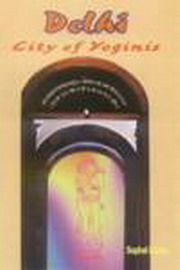
My exploration of Delhi this winter not only introduced me to the soul of the city I live in. But also, to many co-explorers who have been on this journey for much longer and continue to explore this city. I got to know the journey of journalist Suphal Kumar through this book Delhi City of Yoginis. That he wrote after he explored the spiritual aspect of Delhi, as it existed when this city was born, over the ages. And as it exists now.
Through Delhi City of Yoginis, the author has tried to look at the spiritual aspect of the city of Delhi. Especially trying to carve out its Hindu identity as it would have existed before the Sultan era. From the time of Mahabharata until the time of Chauhans and Tomars, there must have been temples and other spiritual bodies that would have been created. But unfortunately very little remains of those times. He takes you through some of the remaining ancient temples. Though most of them hardly tell you anything of their past glory today. He also tells you about the semi-circular formation of Delhi on the banks of the Yamuna which has an uncanny resemblance to the way Banaras is settled around Ganga.
Based on his Pauranik knowledge and his study of this city, the author says that Delhi’s presiding deity is Goddess Yogmaya. Probably that is why you still see most people coming to the mother during Navaratras twice a year. He also points out the numerous Bhairon and Shani temples in and around the city. What is intriguing is that the dimensions of Delhi as described in scriptures with reference to the Yamuna, more or less still define the city limits of Delhi. Except that Surajkund is not technically part of Delhi state today.
Read More – Ancient Yogmaya Temple in Delhi near Qutub Minar.
I loved his chapter on Zero Hour. Comparing the questions that Narada asked the kings to ensure the welfare of the states vis-à-vis the questions that are today asked in the parliament. The questions remain the same. And the answers tell you the state of the state. Also how well are the leaders placed to address those questions?
I also enjoyed his explanations of various inscriptions in and around Parliament, which are definitely not self-explanatory. I am not sure if many people look at them and try to understand their relevance in the context of the place they have been put at. Once you read the explanation you are bound to admire the person who put them there. For their knowledge of the ancient texts. And in their placement their vision for the country.
In the section on Sacred Spaces, he covers various ancient and sacred places in Delhi. One cannot miss his efforts to locate the places lost in obscurity. Trace original texts, meet people and refer to ancient texts to find all that he can about these places. He himself traveled and spent some time in all these places. So his account of how these places feel as authentic as it can get. And will go long way in documenting the present status of these places.
Read More – Surajkund – Heritage of Haryana
I particularly liked his description of Surajkund, which was a part of the erstwhile Delhi and the dam that he described there. He also explores the possibility of a Sun temple being there which today is difficult to locate. It obviously has been added to the list of places that I need to visit in Delhi along with temples at Nigambodh and ruins at Qila Rai Pithora. I wondered at his explanation of the Mandala and formation of cities around it. And the prescribed ways of setting up cities in the scriptures. He also mentions the power of these sacred spaces by giving examples of the incidents that followed when people tried to fiddle with these spaces.
Read More – Walkthrough 1857 Revolution in Delhi
A whole section of Delhi City of Yoginis is devoted to Mutiny or the first war of independence. The author seems to believe that the British period was probably the worst for Delhi. And he is not very appreciative of their contribution to the city or the country. He also condemns the governments of ignoring the Indian war of independence and paying more attention to international events like 9/11. This is probably where the journalist in him takes over.
Suphal Kumar is a proud Banarasi and this comes across in his rustic and straightforward writing style. There are a lot of journalistic views that come across throughout the book. Which initially looked out of place and out of proportion to me. But after I finished the book they did not appear so much out of order.
Do read this book, if you can comprehend spaces are associate sacredness with them or if the sacred history of Delhi intrigues you.
Buy this book – Delhi City of Yoginis at Amazon India.
Suphal Ji, thank you for sending me this book Delhi City of Yoginis.
More books to explore on Delhi:
- Delhi by Khushwant Singh
- Delhi – Adventures in a Mega City by Sam Miller
- City of Djinns by William Dalrymple
- Delhi – Mostly Harmless by Elizabeth Chatterjee
- Delhi – 14 Historic Walks by Swapna Liddle








